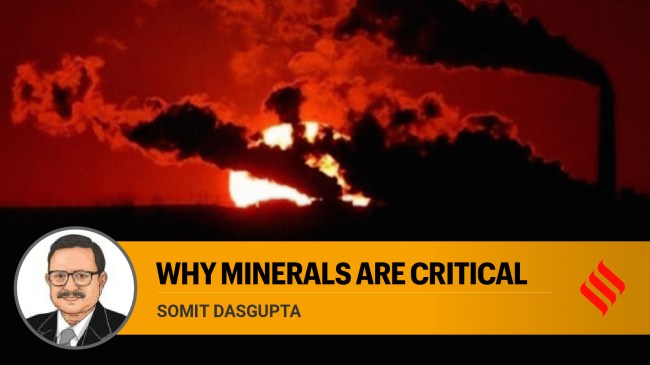Opinion The biggest roadblock to India’s net-zero goal
The problem is that the availability of the minerals is not enough. One needs to process it and manufacture the final product which also means access to technology. What we are looking at is a gestation period of about 15 years or more.
 By 2030, India wants to set up 500 GW of non-fossil fuel power generating capacity.
By 2030, India wants to set up 500 GW of non-fossil fuel power generating capacity. Two important steps have been taken by the government in the past year on the subject of critical minerals. The first was to identify a list of 30 critical minerals (apart from rare earths, which are clearly identified in the periodic table) in July 2023 and the second was to amend the existing mining laws in November 2023 to allow private sector participation in the auction of 20 blocks of critical minerals/rare earths. Critical minerals have no particular definition and countries identify the minerals critical to them using their own criteria. The US has identified 50 minerals while Japan has identified 31. Critical minerals and rare earths should not be used interchangeably as is done very often. India has identified 30 critical minerals depending upon their disruption potential, substitutability, cross-cutting usage across different sectors, import reliance, recycling rates etc. The states/UTs which house these 30 identified critical minerals are Bihar, Gujarat, Jharkhand, Odisha, Tamil Nadu, Uttar Pradesh, Chhattisgarh and Jammu and Kashmir.
Though one needs critical minerals for decarbonisation, it is not limited to just that. They are also required for fertilisers, construction, magnets for industries, transport, consumer electronics, defence, etc. As far as decarbonisation is concerned, one may note that when it comes to building a solar PV plant or a wind farm or electric vehicles, they require more minerals than their fossil fuel counterparts. An electric car needs six times the mineral input when compared to a conventional car and an on-shore wind plant requires nine times more mineral resources than a gas-fired plant. The International Energy Agency (IEA) has estimated that in order to meet the Paris Agreement targets, the share of clean energy technologies in the total demand for critical minerals over the next two decades would be over 40 per cent for copper and rare earths, 60-70 per cent for nickel and cobalt and 90 per cent for lithium. In general, mineral demand for clean energy technologies would rise by at least four times by 2040 to meet the climate goals.
This massive surge has certain implications for this sector. These resources are concentrated in a few countries and, in the case of lithium, cobalt and rare earths, the world’s top three producing nations control well over three-fourths of global output. Specifically, Australia has 55 per cent of lithium reserves, China has 60 per cent of the rare earths, Democratic Republic of Congo (DRC) has 75 per cent of cobalt, Indonesia has 35 per cent of nickel, Chile has 30 per cent of copper reserves.
When it comes to critical minerals/rare earths, China needs a special mention. Not only does it have a major share of rare earth reserve, it has also completely monopolised the processing capacity of these minerals. China processes 35 per cent of the world’s nickel, 50-70 per cent of lithium and cobalt and nearly 90 per cent of rare earths. Not just that, Chinese companies have made investments in Australia, Chile, Indonesia and the DRC, among others, to source those minerals which it is not endowed with sufficiently. China has also monopolised the manufacture of finished products as it supplies 78 per cent of cathodes, 85 per cent of anodes, 70 per cent of battery cells and 95 per cent of permanent magnets made from rare earths. It would be pertinent to add that the Mountain Pass Mine, a rare earth mining company based in the US, exports a major part of their output to China since they do not have processing capacity within the country. In the past, the US was happy to have the processing done in China since it was cheaper and because processing is very energy intensive and leads to a lot of carbon emissions.
China, incidentally, has been using its monopoly position on rare earths to settle political scores with countries like the US and Japan by restricting their exports and also the related technology. China’s dominant position in the business of critical minerals and its willingness to arm-twist other countries has clearly rattled the world community. It has led to the formation of the US-led Minerals Security Partnership (MSP). India, too, has joined the MSP. The aim of the MSP is to bolster the critical minerals supply chain. The MSP includes countries like Australia, Canada, Sweden and Norway, which have deposits of critical minerals, and also countries like Japan and South Korea which have access to processing technology. It would, however, be interesting to note that the MSP does not include countries like Chile, DRC, Indonesia etc. (which are rich in certain critical minerals), raising concerns about its effectiveness. The basic premise of MSP is “friend shoring”, meaning moving manufacturing away from authoritarian states (read China) to allies.
As far as India is concerned, the availability of critical minerals (and rare earths) is crucial as it has massive plans for decarbonisation and to become net-zero by 2070. By 2030, India wants to set up 500 GW of non-fossil fuel power generating capacity. It also wants 30 per cent of private cars, 70 per cent of commercial vehicles and 80 per cent of two/three wheelers to go electric. All this will not be possible without a steady source of lithium and other minerals required to manufacture batteries. As of now, India is completely dependent on imports for most of the critical minerals. India has signed an agreement with Australia to jointly explore for lithium and cobalt assets in Australia. The problem is that the availability of the minerals is not enough. One needs to process it and manufacture the final product which also means access to technology. What we are looking at is a gestation period of about 15 years or more. There is a big fear that lack of access to critical minerals may be the biggest roadblock to India’s march towards decarbonisation.



